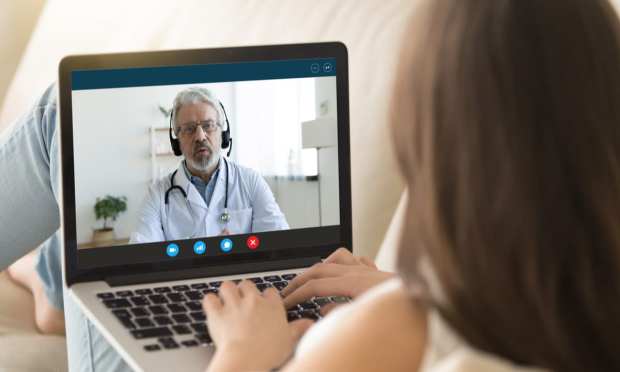Prepping For The Telehealth Future

Telehealth, during the pandemic, was a lifesaver for countless doctors nationwide, like Dr. Corey Howard, who needed to continue carrying on a relationship with his patients even after the pandemic put the kibosh on having patients come in the doors to his practice.
“I’m in solo practice and I do accept Medicare and insurance, and I had a platform before and I failed miserably. And in the beginning of COVID, my practice … came to a halt and I really needed something in these virtual visits, which allowed me to have new patient visits, follow-ups, lab discussions and some acute non-emergent medical issues that fit certain criteria really helped,” Howard explained during a recent American Medical Association (AMA) panel on The Telehealth Initiative collaboration to support physician practices and implementing and using telehealth.
Howard noted that that initiative enabled the nearly overnight transition his practice had to make as it gave him the tools he needed to get control of his workflow, select vendors, optimize his virtual practice and, perhaps most important, “how to code properly and how to get paid.”
Working in tandem and from a common playbook provided by the initiative allows practitioners nationwide to rollout telehealth services for the patients a matter of weeks — when under normal circumstances, Dr. Dhrumil Shah, chief medical information officer, COMPASS Medical, explained to the panel, would have taken six months to a year of careful planning even to start implementing.
The commentary reflects what PYMNTS has heard from telehealth innovators over the course of the last year. CEO Murray Brozinsky of virtual-care platform Conversa Health explained to PYMNTS last June that while telehealth has been around for a while — that the pandemic provided the impetus it needed to finally get moving among providers and consumers on a mass scale.
“What telehealth likely required was a catalyst, [and] COVID-19 has now been that catalyst that pushed it … right over the edge by laying bare a lot of the issues that have been within the system for this whole time,” he said. “And in addition to those, these days nobody wants any compromised patients coming anywhere near a clinic unless they have to be there. So, this notion of keeping patients connected without getting them infected has become kind of an additional mantra for us.”
Moreover, Doctor On Demand CEO Hill Ferguson told PYMNTS — apart from pushing telehealth over the tipping point for both patients and providers — the pandemic has created the kind of institutional support from major players like the AMA, U.S. Centers for Disease Control and Prevention (CDC) and the World Health Organization (WHO) who are now advocating a product and a process that they had spent years being tepid to, at best. A century’s worth of habituation is not an easy thing to overcome among consumers, he noted. Still, the tailwinds pushing virtual medicine have now become impossible to ignore both in terms of practicalities around the effective provision of care and in terms of support within the industry itself.
“It’s great when other organizations are spreading that message for us, which is what we have now when the World Health Organization, CDC and others are actually recommending telemedicine as a great method to seek care,” Ferguson noted.
And that institutional support, the AMA panel indicated, isn’t merely a symptom of the global pandemic currently creating such a roadblock to face-to-face meetings with patients. The lesson of the last year has been, according to Shannon Vogel, associate vice president, health information technology at the Texas Medical Association, is that telehealth by its nature can and will be used in tandem with physical services to provide all-around better and more comprehensive care for patients across the board.
Telehealth may not stay at its current unprecedented levels, she noted, but it’s not going away either. It heretofore will be another tool in the arsenal.
“We’re not going back. Patients and physicians alike have dipped their toes into this or jumped in fully and recognize the value. Patients realize that their time is now efficiently used. They’re not having to drive across town, fight traffic, find parking, sit in the waiting room. It’s more efficient for everybody. Physicians can overlay this as an efficiency to their practice as well. And also if they’re participating in any sort of value-based models, the ability to do brief check-ins with patients can be extraordinarily valuable for those patients that need it the most.”
A sentiment PYMNTS has heard before, care of VillageVoice CEO Tim Barry, who told Karen Webster that telehealth isn’t just a tool to act as a stand-in for going to the doctor’s office, but a doorway to better clinical outcomes premised on more holistic treatment plans enabled the digital tools telehealth puts in physicians hands.
“The goal is to offer an access point to a comprehensive model that says: ‘For as long as you’re trying to manage a condition, we’ve got a team of people and we’ve got a set of technologies that are going to be working with you to make sure that we get better outcomes,’” he noted.
And interestingly, it is access that remains the big concern of both the AMA and others as the pandemic period begins to end and the emerging telehealth industry considers its future. Some 21.3 million Americans don’t have access to high-speed broadband, and tens of millions of others rely on cellular web service instead of broadband for their access point. Those access questions may be answered by the latest round of spending to address the pandemic and its fallout — the $3 trillion legislation package currently proposed by the president. The package would expand funding and accessibility for telehealth services for patients.
Expansion that the AMA agrees is necessary and needed because medicine’s future, the panel agreed, will now be digitized — a situation that can only be as beneficial for patients as it is accessible by them.